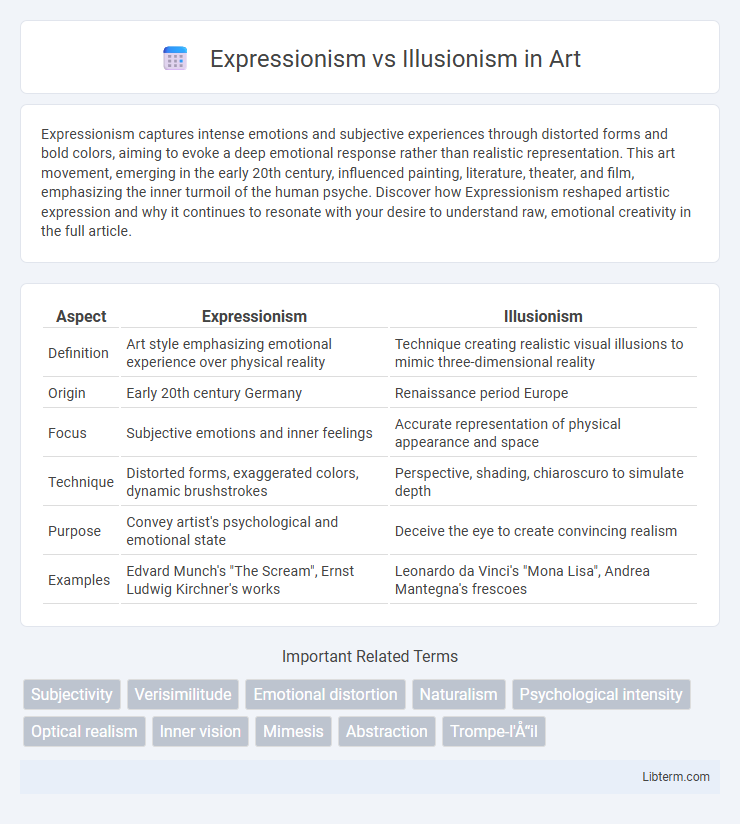Expressionism captures intense emotions and subjective experiences through distorted forms and bold colors, aiming to evoke a deep emotional response rather than realistic representation. This art movement, emerging in the early 20th century, influenced painting, literature, theater, and film, emphasizing the inner turmoil of the human psyche. Discover how Expressionism reshaped artistic expression and why it continues to resonate with your desire to understand raw, emotional creativity in the full article.
Table of Comparison
| Aspect | Expressionism | Illusionism |
|---|---|---|
| Definition | Art style emphasizing emotional experience over physical reality | Technique creating realistic visual illusions to mimic three-dimensional reality |
| Origin | Early 20th century Germany | Renaissance period Europe |
| Focus | Subjective emotions and inner feelings | Accurate representation of physical appearance and space |
| Technique | Distorted forms, exaggerated colors, dynamic brushstrokes | Perspective, shading, chiaroscuro to simulate depth |
| Purpose | Convey artist's psychological and emotional state | Deceive the eye to create convincing realism |
| Examples | Edvard Munch's "The Scream", Ernst Ludwig Kirchner's works | Leonardo da Vinci's "Mona Lisa", Andrea Mantegna's frescoes |
Defining Expressionism and Illusionism
Expressionism emphasizes emotional experience through bold, distorted forms and vivid colors, aiming to evoke subjective feelings rather than replicate reality. Illusionism focuses on creating lifelike images that deceive the eye, using techniques like perspective and shading to mimic three-dimensional space. Both approaches diverge in purpose: Expressionism prioritizes emotional truth, while Illusionism seeks visual accuracy.
Historical Origins and Development
Expressionism originated in early 20th-century Germany as a reaction to industrialization and urbanization, emphasizing emotional experience over realistic representation. Illusionism, tracing back to the Renaissance, developed through techniques like linear perspective and chiaroscuro to create lifelike depth and realistic spatial effects in art. The divergence highlights Expressionism's focus on subjective interpretation versus Illusionism's pursuit of visual accuracy and three-dimensional space on a two-dimensional plane.
Core Philosophies and Aesthetics
Expressionism prioritizes conveying emotional experience through distorted forms and vivid colors, emphasizing subjective perception over realistic representation. Illusionism focuses on creating a lifelike appearance by mimicking the visual reality through precise techniques such as shading, perspective, and detail, aiming to deceive the viewer's eye. The core philosophy of Expressionism challenges objective reality to reveal inner truths, while Illusionism upholds faithful depiction of the external world to enhance visual authenticity.
Key Artists and Movements
Expressionism, characterized by artists like Edvard Munch, Egon Schiele, and Ernst Ludwig Kirchner, emphasized emotional experience over physical reality, emerging primarily through the Die Brucke and Der Blaue Reiter movements. Illusionism, rooted in Renaissance techniques and advanced by artists such as Caravaggio and Johannes Vermeer, focused on creating lifelike representations using perspective, light, and shadow to deceive the viewer's eye. While Expressionism disrupted traditional realism to evoke subjective feelings, Illusionism sought to perfect visual accuracy and depth on a two-dimensional surface.
Techniques and Visual Characteristics
Expressionism employs bold brushstrokes, distorted forms, and exaggerated colors to convey intense emotional experiences, prioritizing subjective interpretation over realistic representation. Illusionism relies on techniques like linear perspective, chiaroscuro, and meticulous detailing to create lifelike images that simulate depth and three-dimensionality. While Expressionism emphasizes emotional impact through abstraction, Illusionism focuses on visual accuracy and the faithful depiction of reality.
Emotional Impact vs Realistic Representation
Expressionism prioritizes emotional impact by distorting forms and using vivid colors to evoke intense feelings, often sacrificing realistic representation for subjective experience. Illusionism emphasizes realistic representation through precise techniques like perspective and shading, creating lifelike images that mimic reality. The emotional power of Expressionism contrasts with Illusionism's meticulous accuracy, highlighting different artistic aims in visual storytelling.
Expressionism in Modern Art
Expressionism in Modern Art prioritizes emotional experience over realistic representation, using distorted forms and vivid colors to evoke intense feelings. Unlike Illusionism, which aims to create lifelike images through techniques like perspective and shading, Expressionism emphasizes subjective perception and inner turmoil. This movement, prominent in early 20th-century works by artists such as Edvard Munch and Egon Schiele, challenges traditional aesthetics by conveying psychological truth rather than visual accuracy.
Illusionism in Contemporary Practice
Illusionism in contemporary art emphasizes hyperrealistic techniques and three-dimensional effects to create convincing visual deceptions that challenge viewers' perceptions. Artists employ advanced materials and digital technologies to blur the boundaries between reality and representation, enhancing immersive experiences. This approach contrasts with Expressionism's focus on emotional intensity and subjective interpretation, highlighting Illusionism's commitment to replicating tangible reality in innovative ways.
Influence on Other Art Forms
Expressionism profoundly influenced literature, theater, and film by emphasizing emotional intensity and subjective perspectives, inspiring playwrights like August Strindberg and filmmakers such as Fritz Lang. Illusionism, rooted in creating lifelike visual effects, shaped architectural decoration and stage design by promoting realistic spatial depth and perspective, seen in Renaissance frescoes and Baroque theater sets. Both movements contributed to graphic arts and dance, with Expressionism fostering abstract choreography and Illusionism enhancing visual storytelling techniques.
Legacy and Continuing Debates
Expressionism revolutionized modern art by emphasizing emotional experience and subjective interpretation, influencing numerous 20th-century movements and contemporary artists seeking personal and psychological depth. Illusionism, rooted in meticulous technique that creates the illusion of reality, continues to spark debates about art's purpose, authenticity, and viewer perception, especially in photorealism and hyperrealism. The legacy of both styles endures through ongoing discussions on whether art should replicate external reality or evoke inner emotional truths.
Expressionism Infographic

 libterm.com
libterm.com